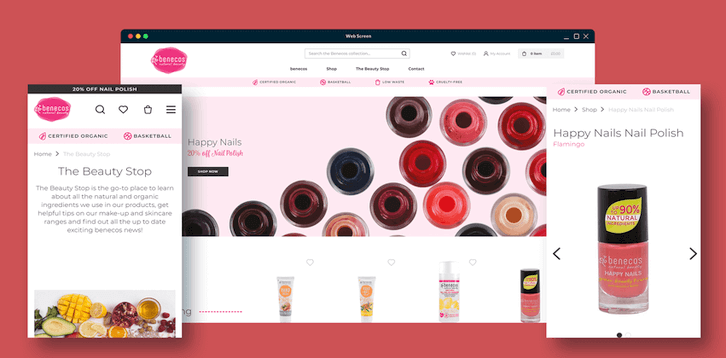Mobile commerce is now one of the most prevalent eCommerce trends and is expected to grow strongly in the near future. Leverage the mobile shopping experience with the Magento mobile shopping app.
For the past few years, the unprecedented development of the eCommerce industry has led to many new online shopping trends arising in parallel, in which mobile commerce has gradually become a familiar term.
Put simply, mobile commerce (or m-commerce) refers to all transactions that are made via smart devices, including smartphones, tablets, and the like.
Thanks to its undeniable benefits, such as convenience and ubiquity, and localization, especially for millennials and Gen Z customers who always prefer the easiest and smartest options.

Table of Contents
The current mobile commerce situation
In 2021, it is forecasted that the worldwide m-commerce share in the eCommerce industry will reach 72.9% globally. This number backs up the fact that many retail brands have decided to go into the eCommerce industry with a mobile-first mindset.
Though at first, a mobile-first approach for web design and development seems to be quite difficult.
A mobile-first strategy will soon become a global approach for businesses that aims at growth across all devices and customer segments.
It’s not too soon to say that your Magento store will not go far away from that trend. If you want to expand your Magento business, or simply want to maintain business growth, it’s of great importance that you take a leap to the advancement of mobile commerce right from today.
We believe the mobile-first approach can transform your Magento for the better, and in this article, we will go with you through best practices to a better mobile experience at your Magento store.
Best practices to leverage the mobile shopping experience at your Magento store
Implement a mobile-friendly website
The first practice to an excellent mobile shopping experience at your Magento store is to implement a mobile-friendly online store. A mobile-friendly website should function beautifully on all devices, be it a computer, tablet, or smartphone. Regardless of the device users are browsing your Magento store on, it’s essential that there are no usability concerns.

Technically, Magento 2 is natively responsive irrespective of all devices used, and by default, your web store can be effortlessly adjusted to any screen size and resolution.
However, this requires you to implement responsive themes that can offer better mobile responsiveness, and add some mobile features to your Magento store.
Improve page load time
In the age where people are living a fast-paced life, it’s no longer a secret that every second delay in your Magento website will become the catalyst for interrupting the buying process, and later result in a low conversion rate.
Therefore, a successful Magento store designed with a mobile-first approach should load in less than three seconds, and ideally less than two. You can achieve fast website load times:
- Optimize image and above-the-fold content first
- Make page size as small as possible
- Implement AMP protocols
- Remove unnecessary JavaScript or other redundant elements
Simplify checkout process
Closely following the eCommerce customer journey, the final step that stands between a sale and your customer is a checkout screen. An intuitive checkout experience will move them toward the checkout cart and finally, make a purchase at your Magento store.
There are many things you need to take care of on the checkout screen, such as process orders, collecting information, decide on payments and shipping methods.
It looks quite complicated and time-consuming on smart devices with such small screens.
For mobile users, it’s vital that your checkout screen should be clear and concise. All the buttons need to be large and bold enough, and the form should be easy to fill out.
If your Magento checkout page keeps reloading, or users have difficulties in filling out or the form, there’s a high chance that they will feel disturbed and leave your site without completing their orders.
Eliminate pop-ups and ads
Pop-ups and ads are two traditional marketing tactics that many eCommerce stores still utilize with the hope of catching customers’ attention.
However, only take in this marketing tactic when you are sure that customers prefer what your ads display, and they will want to learn more about it. Otherwise, invasive pop-ups and ads can intensely annoy visitors, and it might even lower your store’s rank on SERPs.
For the mobile version, it’s even more strictly on how you can place pop-ups and ads on your Magento store. Considering removing all the unnecessary pop-ups on smart devices is a should-follow tactic to enhance the mobile shopping experience at your Magento store.
Make it easy to navigate
Once landing at your Magento store, mobile users should immediately understand the structure of your site, and where they can go to find their needed information. An easy navigation bar can be harder to implement on mobile screens and visitors can easily get lost.
Therefore, another best tactic you should apply is to offer a seamless purchasing journey on Magento mobile shopping apps, which is intuitive and easy-to-follow navigation.
At the most basic level, you need to display all basic UI elements. Such as the main menu, search bar, product category, shopping cart, and account for mobile customers.
It’s worth taking notice of the screen size limitation. You might not be able to include all the pages or tabs on the desktop version. So make sure you select the most important ones and make them easily accessible for mobile users.
Invest in Magento mobile shopping app
The most practical method you can apply to enhance the mobile shopping experience at your store is to invest in a Magento mobile app.
For customers using mobile to shop, what they need most is a quick, simple, and seamless shopping experience. That’s when a native shopping app comes in handy.
A Magento mobile app can offer many built-in features that improve your store UX on mobile and deliver personalized customer experiences.
When it comes to customer relationship management, a mobile app helps you solve any issues through live chat and direct messages. It can greatly enhance the customer experience at your Magento store.
Moreover, an excellent mobile shopping app can become a practical weapon to help you increase your retention rate.
As 49.43% of users are still using mobile apps after they have downloaded the app for one month. It’s obvious that the marketing tactics you apply in Magento mobile app can be effective in improving the retention rate at your store.
Optimize content for mobile shopping app
Website content is an indispensable part to boost up your SEO and engage customers. But heavy content can make your site slow to load or hard to view on mobile.
Therefore, it’s essential that you carefully check your site content to make sure all the features, such as blocks of text, white spacing, and blog images are arranged nicely.
Also, when viewing through mobiles and tablets customers might find some long contents missing. You need to review content on mobile regularly to make sure that the content in your Magento store, either on the home page or on the blog page, is perfectly optimized for users browsing through smart devices.
Conclusion
Customers nowadays have formed a habit of using mobile shopping apps to look for products, brand information and browse your Magento store, no matter where they live. As mobile commerce is an inevitable trend. You need to immediately take action to catch up with this global trend that is expected to strongly grow in upcoming years.
Mobile optimization for Magento stores is all about putting yourself in your customer’s shoes. And providing the easiest and most comfortable way to help them find what they want to buy. Store owners should utilize some practices in our list above from time to time. We hope that you can take advantage of Magento mobile app optimization to stay ahead of the shopping game.















































